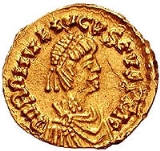What were some of the highlights of the decline?
replied to: tjared
Replied to: What were some of the highlights of the decline?
Theodosius (379-395) was the last emperor to unify the east and west; he outlawed paganism and ushered in Christianity.
replied to: bulldog1
Replied to: Theodosius (379-395) was the last emperor to unify the east and...
In 405 or 406 bands of Vandals, Suebi and Alans sacked Gaul; Rome would never regain control of these lands.
replied to: tjared
Replied to: What were some of the highlights of the decline?
- The economic policies of the emperors (the increase in taxation to counterbalance the growing expenses for the army and the bureaucracy). This trend started under Septimius Severus.
- The defensive attitude in the foreign policy: a defensive war is much more expensive than an offensive war, because the second one may be financed through foreign resources and does not imply costs of reconstruction. Indeed, an "offensive attidude" restrains enemies' ambitions. This psychological process started under Hadrian.
- the civil wars during the III centuries. From the death of Alexandrus Severus (235 ad) to the ascent of Diocletianus (284 ad) at least 19 emperors succeeded to the throne; in this period the empire was in trouble because of the concomitant barbarian invasions, caresties, bloody civil wars. this brought about a strong economic crisis, that even Diocletianus wasn't able to face.
- the bloody civil war between the usurpator Magnetius and Costantius II in 351. In the only battle of Mursia Maior, the whole western army was slaughtered (40000 losses). From now on, the western empire recruited barbarian troops.
- the advent of the Huns, the battle of Hadrianople and the invasions of Goths.
- Weak emperors (Honorius, Arcadius, Valentinianus III)
- the fall of the Gaul (407-408)
- the fall of Africa.

